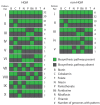Systematic genome assessment of B-vitamin biosynthesis suggests co-operation among gut microbes
- PMID: 25941533
- PMCID: PMC4403557
- DOI: 10.3389/fgene.2015.00148
Systematic genome assessment of B-vitamin biosynthesis suggests co-operation among gut microbes
Abstract
The human gut microbiota supplies its host with essential nutrients, including B-vitamins. Using the PubSEED platform, we systematically assessed the genomes of 256 common human gut bacteria for the presence of biosynthesis pathways for eight B-vitamins: biotin, cobalamin, folate, niacin, pantothenate, pyridoxine, riboflavin, and thiamin. On the basis of the presence and absence of genome annotations, we predicted that each of the eight vitamins was produced by 40-65% of the 256 human gut microbes. The distribution of synthesis pathways was diverse; some genomes had all eight biosynthesis pathways, whereas others contained no de novo synthesis pathways. We compared our predictions to experimental data from 16 organisms and found 88% of our predictions to be in agreement with published data. In addition, we identified several pairs of organisms whose vitamin synthesis pathway pattern complemented those of other organisms. This analysis suggests that human gut bacteria actively exchange B-vitamins among each other, thereby enabling the survival of organisms that do not synthesize any of these essential cofactors. This result indicates the co-evolution of the gut microbes in the human gut environment. Our work presents the first comprehensive assessment of the B-vitamin synthesis capabilities of the human gut microbiota. We propose that in addition to diet, the gut microbiota is an important source of B-vitamins, and that changes in the gut microbiota composition can severely affect our dietary B-vitamin requirements.
Keywords: B-vitamin biosynthesis; PubSEED; genome annotation; gut microbiota; subsystem.
Figures










References
Grants and funding
LinkOut - more resources
Full Text Sources
Other Literature Sources
Molecular Biology Databases

